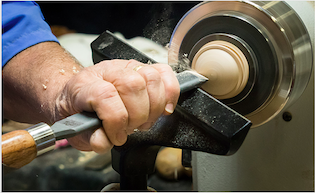It Goes Around
The Enchantment of Woodturning
by Betty J. Scarpino
 Enchantment results from the process of making wood shavings—they pile up on shop floors and are the fuel for compost, regeneration, and growth. Our lathes keep us engaged and interested in working wood in a way that other forms of woodworking do not equal.
Enchantment results from the process of making wood shavings—they pile up on shop floors and are the fuel for compost, regeneration, and growth. Our lathes keep us engaged and interested in working wood in a way that other forms of woodworking do not equal.
Instant gratification is part of the lure—a wooden salad bowl can be created in less than a day, from log to dinner table. Chainsaw a log into turning blanks, mount the blanks onto a lathe, apply a turning tool, and shape the wood. Any form from a bowl to a baluster is possible.
Lathes have been around for centuries, way before the advent of electricity. Powered by waterwheels or human beings, lathes have helped woodturners easily shape wood from square to round, as well as simplified the hollowing of bowls, cups, and other such treenware.
Wood mounted on a lathe can be worked freshly cut (green) or dry, with air-dried wood generally preferable to the kiln-dried variety. And unlike other machines in a shop, the lathe moves the wood, spinning it around. As the wood spins, a woodturner holds a sharp tool, which rests on a toolrest. The turner advances the tool into the spinning wood to remove the unwanted mass inside a bowl. Shavings fly!
There are two basic methods of turning: faceplate turning and spindle turning . In faceplate turning, the wood is attached to the lathe with the grain running perpendicular to the bed of the lathe. For spindle turning, the wood is attached so that the grain runs parallel to the bed of the lathe. Wood grain matters.
To attach a piece of wood to the lathe for making a bowl, the turner can screw it to a faceplate, or grab it in a mechanical chuck. For spindle turning an item such as a rung for a chair or a candleholder, the piece of wood would be held between the drive center and the tailstock. For turning a hollow vessel, the wood could be mounted either way—between centers as for spindle turning, or attached to a faceplate or mounted in a chuck.
Live centers go with the tailstock, drive centers go into the headstock, faceplates and chucks thread onto the drive spindle—admittedly, lathe terminology can be various and confusing. But the basic process of wood- turning remains straightforward and simple: attach a piece of wood to a lathe so it can rotate around and around, apply a sharp tool to the whirling wood, make shavings until the wood that’s left on the lathe has taken the form the turner set out to create in the first place.
Function primarily defines treenware. However, for many contemporary woodturners, function takes back-stage to form and beautiful grain patterns found inside the wood. Bragging rights for burls, curl, crotch wood, and flame patterns are what it’s all about. Function is simply the excuse . . . we need reasons and justifications for the thousands of dollars required to set up a proper workshop. Machine and tool manufacturers have taken heed; the offering of lathes, tools, and woodturning supplies has grown exponentially during these past 25 years.
The field of contemporary wood art is relatively new. Primarily driven by a handful of woodturners, it is enriched by the fascinating combination of hobbyists, amateurs, and professionals. Work from our lathes is expressive and of unimaginable shapes and forms and has spawned sub-categories defined by such words as hollow vessels, multi-axis, eccentric, segmented, therming, lost-wood, reassembly, inside-out, reshaping, carving, and pen making. All are lathe-based, many defy the label of woodturning, but we embrace them all (and you will find them all defined and explained as you turn the pages of this book).
No longer is the thin-walled vessel the line that separated treenware of the past from the contemporary works off the lathe. Woodturners make, exhibit, and sell massive pieces, tiny wonders, wavy green-turned nested vessels, hollow forms, teapots, offset-candle holders, and sculpture. Turned pens fetch thousands of dollars. Museums and private collections vie for the best turned-wood objects.
With as very few exceptions, woodturning programs have not appeared in university art departments. Instead, most woodturners are self-taught through woodturning programs at schools like Arrowmont School of Arts and Crafts, the Center for Furniture Craftsmanship, and Anderson Ranch Arts Center. Many professionals offer small group instruction, held in their private studios. National, regional, and mini-symposiums are ongoing, almost weekly.
The woodturning movement spawned several organizations. Or perhaps several organizations were instrumental in causing the woodturning movement. Arguments abound for every version of our recent history. The American Association of Woodturners, the Wood Turning Center, and the Collectors of Wood Art, are the major organizational players. Within the AAW, local chapters and their national symposiums are hotbeds for information sharing.
And share we do. The woodturning field is perhaps unique in that there are almost no secrets. Why keep techniques and methods secret when the true ingredient of a successful turned object is the craftsmanship and individual approach infused into the wood.
Copyright 2011, American Association of Woodturners, Woodturning Today: A Dramatic Evolution, Woodturning Before 1985, p13. All rights reserved.